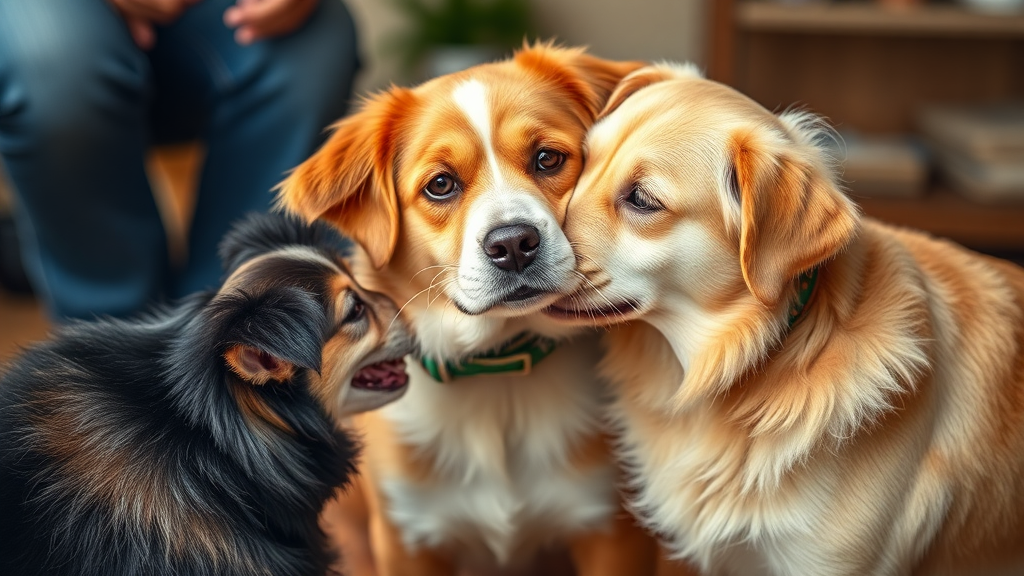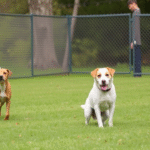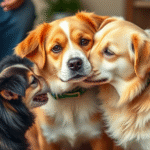Do Dogs Like When You Pet Them? Understanding Canine Affection
Dogs often show their affection in various ways, and petting plays a significant role in nurturing that bond between humans and their furry friends. Understanding whether dogs like being petted not only strengthens that connection but also enhances your relationship with your pet.
When you pet a dog, you’re not just providing physical comfort; you’re also engaging in a form of communication. Most dogs enjoy the sensation of being petted, especially if they trust the person doing the petting. This trust is crucial because a dog in distress or discomfort will not respond positively to touch. So, do dogs like when you pet them? Let’s explore this further.
Factors Influencing a Dog’s Preference for Petting
Not all dogs react the same way to being petted. Here are some factors that can influence their response:
- Breed: Some breeds are more affectionate and enjoy being petted, while others may be more independent. For example, Labrador Retrievers typically enjoy attention, while some working breeds might prefer minimal interaction.
- Socialization: A well-socialized dog usually enjoys petting. Dogs that have positive early experiences with people are more likely to seek out tactile affection later in life.
- Past Experiences: If a dog has had negative experiences with humans or similar situations, they might shy away from petting. It’s essential to consider a dog’s history when determining its comfort level with touch.
- Individual Personality: Just like people, dogs have their own personalities. Some may crave physical touch, while others may be more reserved.
Signs That Your Dog Enjoys Being Petted
Now that you know the factors influencing a dog’s comfort level with petting, how can you tell if your dog enjoys it? Here are some signs to look for:
- Leaning into You: If your dog leans against you while you pet them, it’s a positive indication that they enjoy the attention.
- Relaxed Body Language: A relaxed posture, with soft eyes and a wagging tail, indicates that your dog is comfortable. If they are tense or trying to move away, it’s time to pause.
- Playful Behavior: If your dog playfully nudges your hand or brings a toy over while you’re petting them, they are likely enjoying the moment.
- Offering Their Belly: Dogs that roll onto their backs, exposing their belly, are often inviting you to pet them in a vulnerable position, showing trust and comfort.
The Best Places to Pet Your Dog
Not every part of a dog’s body is equally receptive to petting. Different dogs prefer to be petted in different spots. Here are some commonly loved areas:
| Preferred Petting Spot | Why Dogs Love It |
|---|---|
| Behind the Ears | This is often a favorite spot because it’s hard for dogs to itch themselves there. |
| Chest Area | Many dogs enjoy being petted on their chest, as it feels warm and cozy. |
| Back and Neck | Light strokes along the back can be soothing and relaxing for dogs. |
| Belly Rubs | Belly rubs can be a sign of trust and affection, and many dogs love this! |
How to Approach Petting a Dog
Approaching a dog for petting can influence how well they respond. Here are some tips:
- Observe First: Before petting a dog, spend a moment observing their body language. Signs of discomfort can include a tucked tail or a stiff posture.
- Start Slow: Approach the dog calmly and introduce your hand slowly. Let them sniff your hand before making contact.
- Watch for Cues: Watch for signs of enjoyment or discomfort as you pet. If your dog seems relaxed, continue. If not, give them space.
Understanding canine body language and preferences is essential when asking the question, “Do dogs like when you pet them?” Each dog is unique and has its own comfort level regarding petting. Paying attention to their responses and respecting their wishes reinforces trust and strengthens the bond between you.
For more information on dog behavior and care, consider visiting The American Kennel Club or AKC’s Understanding Dog Behavior.
The Science Behind Dog Behavior and Touch
Understanding why dogs react positively to petting can deepen the bond between you and your furry friend. Your dog’s behavior when you pet them reveals a lot about their feelings. Most dogs enjoy affection, but the reasons vary from animal to animal.
First and foremost, physical touch activates a dog’s brain in beneficial ways. When you pet your dog, you may be surprised to learn that it releases oxytocin, often referred to as the “love hormone.” This hormone is the same one that is released in humans when they experience love and trust. The act of petting not only calms your dog but also strengthens the emotional connection between you and your pet.
Dogs are social animals. They are wired to connect with others, including humans. When you engage in petting, you provide them with a form of social interaction that dogs crave. Here are several reasons why your dog loves being petted:
- Affection: A gentle touch communicates love and security to your dog.
- Relaxation: Petting can calm an anxious or nervous dog, creating a sense of peace.
- Bonding: Spending quality time by petting helps reinforce the trust between you and your pet.
- Playfulness: Petting can also lead to more playful behaviors, particularly if your dog enjoys being touched in specific areas.
- Sensory Experience: Dogs experience the world through their senses. Being petted stimulates their skin and fur, adding to their overall joy.
However, not all dogs appreciate touch in the same way. The way a dog responds can depend on factors like breed, previous experiences, and individual personality. For instance, some breeds are more predisposed to enjoy touch due to their breeding for companionship. Breeds such as Golden Retrievers and Labradors often thrive on physical affection, while more independent breeds like Shiba Inus may prefer less direct contact.
It’s important to recognize your dog’s body language when petting them. Signs of enjoyment include:
- Wagging tail
- Relaxed posture
- Leaning into your touch
If your dog shows signs of discomfort, such as growling, flattening their ears, or moving away, it’s a cue to stop or change your approach. Understanding your dog’s preferences is crucial for a positive interaction. Each dog is unique, and what feels good for one might not work for another.
To enhance your petting sessions, consider these tips:
- Focus on areas most dogs enjoy being touched, such as behind the ears, under the chin, and along the back.
- Be gentle and use slow, calming strokes. Quick, erratic movements might startle them.
- Pay attention to their reactions, adjusting your technique according to their body signals.
Research has also shown that dogs may respond differently to various types of touch. For example, soft, gentle stroking tends to calm them, while more vigorous petting might be stimulating and energizing. Experiment with different speeds and pressures to find what your dog enjoys most.
Furthermore, positive reinforcement techniques can also enhance the petting experience. Every time you pet your dog, offer a treat or verbal praise. This combination will help them associate petting with positive outcomes, increasing their enjoyment.
The bond between you and your dog goes beyond just petting. Activities like walks, training, and playtime also contribute significantly to their well-being and happiness. To learn more about enhancing your dog’s life, check out resources from the American Kennel Club or the Humane Society.
In essence, petting is a powerful way to convey love and strengthen the relationship with your dog. Understanding the science behind their behavior and responding to their individual preferences are crucial for a happy and harmonious partnership.
Different Ways to Pet Your Dog for Maximum Enjoyment
When you come home after a long day, nothing feels better than a warm greeting from your dog. You probably find yourself reaching out to pet them immediately, but have you ever wondered if your furry friend truly enjoys it? Understanding the different ways to pet your dog can enhance your time together and strengthen your bond. Here are various techniques that can provide maximum enjoyment for both you and your dog.
Understanding Your Dog’s Body Language
Before you start petting your dog, it’s crucial to observe their body language. Dogs communicate through their posture, wagging tails, and facial expressions. Here are some signs that indicate your dog is open to affection:
- Relaxed Body: If your dog is standing or lying down in a relaxed position, they are likely comfortable with being petted.
- Wagging Tail: A wagging tail, especially if it’s at a slight curve, signals happiness and eagerness.
- Leaning Towards You: When your dog leans in while you pet them, it shows they appreciate the attention.
- Calmness: If your dog stays still or lays down without trying to get away, it’s a sign they enjoy the affection.
Effective Techniques for Petting Your Dog
Now that you understand how to read your dog’s body language, let’s explore different petting techniques that can maximize their enjoyment:
Gentle Strokes
Start with slow, gentle strokes along the back. This motion is soothing and lets your dog relax while engaging with you. Use the palm of your hand rather than your fingertips, as it feels less intrusive to the dog.
Scratching the Right Spots
Dogs have specific areas where they love to be scratched. Pay attention to the following spots:
- Behind the Ears: Many dogs enjoy being scratched behind their ears. It’s often a favorite spot for them.
- Under the Chin: This area is often associated with affection. A gentle scratch there can make your dog feel special.
- On the Chest: Petting or scratching on the chest can evoke feelings of safety and trust.
- Between the Toes: For some dogs, gentle scratching between the toes can be quite enjoyable.
Use Both Hands
Don’t be afraid to use both hands for petting! One hand can stroke the dog’s back while the other focuses on their favorite scratching spot. This dual approach can heighten their enjoyment.
Vary Your Techniques
Just like humans, dogs enjoy variety. Try rotating between petting, scratching, and even light massaging. A gentle massage can be particularly enjoyable for older dogs or those with joint pain. Use your fingers to apply gentle pressure along their muscle groups to help them relax.
Engage Playfully
Combine petting with play. Using toys that squeak or tossing a ball can get your dog excited and more receptive to being petted afterward. After a play session, they may want to settle down and enjoy some affectionate petting.
Respect Their Space
While many dogs love affection, some may not enjoy it at certain times. Always respect your dog’s signals. If they back away or exhibit signs of annoyance, give them some space. It’s essential to create an environment where your dog feels safe and comfortable, as this establishes trust.
Learn from Professionals
For more insights on how to interact positively with your dog, consider resources from [The American Kennel Club](https://www.akc.org) or [ASPCA](https://www.aspca.org). These organizations provide valuable information about canine behavior and training techniques to enhance your relationship with your pet.
Petting your dog can be an enriching experience for both of you. By understanding their language, utilizing effective techniques, and choosing the right moments for affection, you can ensure your dog feels truly cherished. Remember, the goal is to foster a deep bond and keep your furry friend happy!
Signs Your Dog is Enjoying the Affection
If you’re a dog owner, you may often wonder about your furry friend’s feelings when you shower them with love and affection. Understanding the signs that indicate your dog is enjoying your petting can greatly enhance your bond. Dogs communicate primarily through body language, so recognizing their cues is vital. Here are some signs to look for that indicate your dog is happily embracing your affection.
Tail Language
A wagging tail is often one of the first signs to indicate that a dog is happy. However, it’s important to note the position and speed of the wag. Here are some things to consider:
- High Tail Wagging: If your dog’s tail is wagging high and fast, it’s usually a sign of excitement and enjoyment.
- Sweeping Motion: Heavy sweeping motions often mean your dog is thrilled to receive your affection.
- Relaxed Position: A tail that’s not tense but rather relaxed often suggests comfort and enjoyment.
Body Posture
Observe your dog’s body posture during petting. A relaxed body is generally a good indicator that your pup is enjoying the affection. Here are some signs to watch for:
- Relaxed Ears: If your dog’s ears are in a natural position, not pinned back or up, it’s a sign of comfort.
- Slightly Open Mouth: A slightly open mouth paired with a relaxed demeanor can indicate that your dog is at ease and enjoying the moment.
- Leaning In: If your dog leans closer to you while being petted, this shows they are inviting more affection.
Vocalizations
Listen carefully to your dog’s sounds. Dogs may express their joy through various vocalizations. Look for signs like:
- Contented Growls: Some dogs will emit soft growls, which can indicate pleasure rather than aggression.
- Soft Whimpers or Whines: If your dog whimpers in a soft manner, it could signify that they are enjoying the moment and want more interaction.
Physical Reactions
How your dog physically reacts when you pet them is crucial. Pay attention to the following:
- Pawing at You: If your dog places their paw on you, it can be a sign that they want more affection.
- Licking: A gentle lick can indicate your dog is showing love and appreciation for your petting.
- Rolling Over: If your dog rolls onto their back while you’re petting them, it means they trust you and feel safe.
Seeking Attention
Watch if your dog initiates contact. A dog that actively seeks out your touch is likely enjoying your affection. Signs include:
- Approaching You: If your dog comes over to you for attention, this is a clear indicator that they want to be petted.
- Cuddling Up: Dogs that snuggle close are looking for warmth and connection, making it a positive sign they enjoy your affection.
Understanding these signs can enhance the bond between you and your dog significantly. Not only does it create a sense of trust, but it also ensures that your dog feels secure in your companionship. If you want to learn more about dog behavior and communication, check out resources like American Kennel Club.
Bonding with your dog through petting can improve their quality of life and strengthen your relationship. Always pay attention to their cues – this will help you understand their needs and desires better.
If you’d like to delve deeper into how your dog perceives affection and more about dog training, visit Humane Society for valuable insights.
Your dog has a unique way of showing that they appreciate the love you give. By recognizing the signs of their enjoyment, you can create a stronger, more joyful relationship. Always engage with them positively, and remember to enjoy every moment spent together!
The Importance of Bonding Through Touch
Touch is a fundamental aspect of communication and connection, and it plays an important role in human-animal relationships, especially between dogs and their owners. The simple act of petting a dog can create a bond that enhances trust, security, and understanding. But what does this bond mean to both you and your furry friend? Let’s explore how bonding through touch benefits both parties and the essential role it plays in their well-being.
When you pet your dog, you trigger the release of oxytocin, often referred to as the “love hormone.” This hormone plays a significant role in social bonding. As you engage in this simple touch, your dog experiences an increase in oxytocin levels as well, strengthening the emotional connection between you both. This bond not only fosters affection but also can lead to decreased stress levels for both of you.
Why is this bonding through touch so crucial for dogs? Here are several key points:
- Emotional Health: Touch helps dogs feel secure and loved. Just like humans, dogs can experience anxiety and stress. Regular petting can provide comfort and reduce feelings of insecurity.
- Behavioral Benefits: Dogs that receive regular affection through touch are often better behaved. They can develop better coping mechanisms and exhibit less aggression.
- Socialization: Dogs need to learn how to interact with humans and other animals. Positive touch teaches them acceptable behavior, which is crucial during their formative years.
- Physical Health: Petting can stimulate circulation and relax muscles, contributing to your dog’s overall physical wellness. Ambient stress relief from touch can also positively impact their immune system.
Not all dogs respond the same way to touch, so it’s important to understand your canine companion. Some dogs may prefer being petted on their back, while others love belly rubs. Observing their body language will help you identify what they enjoy. Look for signs of enjoyment, such as wagging tails, relaxed body posture, or leaning into your hand. On the other hand, if your dog turns away, flinches, or shows signs of aggression, it’s essential to respect their boundaries.
Here are some effective techniques for petting your dog:
- Start Slow: Approach your dog calmly and allow them to come to you. This establishes trust and makes them feel safe.
- Use the Right Areas: Focus on areas that most dogs enjoy, such as the head, ears, and neck. Avoid sensitive areas unless you’re sure they like it.
- Vary Your Touch: Alternate between soft strokes and gentle scritches to keep the experience enjoyable and engaging for your dog.
For more tips on how to improve your bond with your dog through touch, consider exploring resources such as the American Kennel Club’s article on The Human-Canine Connection.
In addition to petting, there are other activities that foster bonding through touch, such as grooming or playing. Regular grooming not only enhances your dog’s appearance but also provides a great opportunity for bonding. When you brush their fur, you are engaging in a form of touch that can prod feelings of comfort and warmth. Play is another powerful bonding tool; games like tug-of-war or fetch also involve touch and lead to increased joy and excitement for your dog.
Moreover, interactivity deepens the bond between you and your pet. Dogs thrive on interaction, and activities like training or obedience exercises enhance your connection. Here’s a quick overview of how these interactions can benefit your relationship:
| Activity | Benefit | Touch Involved |
|---|---|---|
| Petting | Builds trust and affection | Direct |
| Grooming | Enhances physical health and bonding | Direct |
| Play | Encourages joy and excitement | Indirect |
| Training | Strengthens obedience and connection | Direct |
Bonding through touch is a powerful tool in nurturing and maintaining a strong, healthy relationship with your dog. Remember that every dog is unique; take the time to learn what they enjoy and respond well to. Regular, affectionate touches will not only enhance your dog’s emotional health but will also contribute significantly to your shared happiness. For additional insights on dog care and behavior, visit the ASPCA’s dog care section.
Common Misconceptions About Petting Dogs
Many dog owners love to show affection to their furry friends through petting. However, there are prevalent misconceptions about how dogs perceive petting. Understanding these misconceptions can help you bond better with your pet. Here are some common beliefs and the truths behind them.
Dogs Love to be Petted Anytime
One of the most common misconceptions is that dogs are always ready for a pet. While many dogs enjoy the touch of their human companions, there are times when they prefer to have their own space. For instance, if a dog is tired or anxious, they may not want to be touched. It’s crucial to watch their body language. Signs of discomfort can include:
- Turning away from you
- Whining or growling
- Tensing their body
- Dog tail between their legs
In these situations, it is best to give them some space and let them come to you when they’re ready.
All Dogs Like the Same Type of Petting
Another misconception is that all dogs appreciate petting in the same manner. Just like people, dogs have different preferences. Some dogs love a gentle scratch behind the ears, while others may prefer a belly rub or a pat on the back. Pay attention to how your dog responds when you pet them. Try different techniques and see what they enjoy the most.
Petting is Just About Affection
Many people believe that petting a dog is solely about showing affection. In reality, petting serves multiple purposes. It can also be a way to calm a dog during stressful situations. The pressure of a person’s hand can have a calming effect on anxious dogs. So, while you might be petting out of love, your dog may appreciate it for its soothing benefits, especially during thunderstorms or fireworks.
Petting Always Creates a Strong Bond
While petting can strengthen the bond between you and your dog, it’s not the only way to connect. Some dogs, particularly those that have experienced trauma, may find petting uncomfortable. Building a meaningful relationship often requires more than just physical affection. Take time to engage with your dog through play, training, and interactive activities. These methods can help build trust and create a deeper connection.
Any Human Can Pet Any Dog
This belief can lead to dangerous situations. Not all dogs are comfortable with strangers. Approaching an unfamiliar dog without consent could lead to fear or aggression. Always ask the owner for permission before petting someone else’s dog. If you get the green light, let the dog come to you, or offer your hand for them to sniff before initiating contact.
The Right Way to Pet a Dog
When petting a dog, the approach matters greatly. The most effective way to pet a dog is:
- First, allow the dog to come to you at their own pace.
- Extend your hand for them to sniff.
- Start by petting their side or back, avoiding sensitive areas like the head or tail until you know their preferences.
- Watch for their reaction and adjust your touch accordingly.
Using this technique can help create a more positive experience for both you and the dog.
Final Thoughts on Dog Petting Misconceptions
Understanding these misconceptions can change how you interact with dogs. Always respect a dog’s individual preferences and body language. For more in-depth knowledge about dog behavior, you may visit American Kennel Club or ASPCA. Remember, a dog’s needs vary, and being an attentive and observant owner is key to a happy and healthy relationship with your pet.
How to Read Your Dog’s Body Language While Petting
Understanding your dog’s body language while petting is essential to ensuring a positive experience for both you and your furry friend. Dogs communicate their feelings through various body signals, and recognizing these nuances can help strengthen your bond. Here, we’ll explore some key signals to watch for when interacting with your dog.
Common Body Language Signals
Paying attention to your dog’s body language can reveal a lot about their feelings. Here are some common signs to look for:
- Tail Position: A wagging tail often indicates excitement or happiness, but the position matters. A tail held high usually shows confidence, while a low tail may indicate submission or fear.
- Ears: Ears that are up and facing forward suggest your dog is alert and interested. If the ears are pinned back, it may be a sign of discomfort or fear.
- Pawing or Leaning: If your dog leans into you or puts a paw on you, it’s a clear sign they enjoy your touch. Conversely, if they step back or pull away, it may indicate they want to stop being petted.
- Eyes: Soft eyes with a relaxed expression indicate comfort. If your dog is staring intently or squinting, it could mean they feel threatened.
Positive Signals While Being Petted
When your dog truly enjoys being petted, they will exhibit some of the following positive behaviors:
- Relaxed Body: A relaxed posture, such as lying down with a slightly turned body, suggests contentment.
- Play Bow: If your dog bows with their front legs down, it’s an invitation to play and shows they are happy.
- Gentle Nuzzling: Dogs often nuzzle against you when they seek affection or want more petting.
Signs of Discomfort
Although you may be excited to pet your dog, it’s crucial to recognize when they aren’t enjoying it. Look out for these signs of discomfort:
- Body Tension: A stiff body or tightly held muscles can signal stress. This rigidity is a strong indicator that your dog wants to stop being petted.
- Barking or Growling: Vocalizations can act as a warning. If your dog barks or growls, it’s time to stop and give them space.
- Turning Away: If your dog frequently turns their head or body away from you while you’re petting them, it could mean they’re feeling overwhelmed.
Creating a Comforting Environment
To make petting sessions enjoyable, consider the following tips:
- Gauge Their Mood: Always observe your dog’s body language before initiating petting. Are they relaxed and happy, or do they seem agitated?
- Use Gentle Touch: Some dogs prefer soft strokes, while others may enjoy a firmer touch. Experiment with different techniques to find what your dog enjoys.
- Soothe Them: Speaking softly while petting can create a calming atmosphere, helping to promote a sense of security.
Resources for Further Learning
If you want to deepen your understanding of your dog’s body language while petting, there are several excellent resources available:
- American Kennel Club – Offers comprehensive dog training tips and behavior information.
- Cesar’s Way – Insights from a renowned dog trainer on communication and behavior management.
- Dogster – Articles focused on dog behavior and health that can help you learn more.
By learning to read your dog’s body language, you can enhance your petting experiences and promote a stronger emotional connection. Not only will this benefit your dog, but it will make your time together more enjoyable and fulfilling.
Key Takeaway:
Understanding whether dogs like when you pet them is more than just a simple question; it touches on the broader themes of canine affection, behavior, and the bond between humans and dogs. Recent studies show that dogs thrive on touch, much like humans do. Petting not only satisfies their natural desire for physical contact, but it also helps release oxytocin, often referred to as the "love hormone," which enhances feelings of connection and trust.
To maximize your dog’s enjoyment during petting, it is essential to approach it with awareness. Different dogs have different preferences when it comes to how they like to be touched. For example, many dogs enjoy behind-the-ear scratches or gentle strokes along their sides. The right technique can turn a simple affection into a cherished bonding moment for both you and your furry friend.
Recognizing the signs that your dog is enjoying your petting is just as critical. Look for wagging tails, relaxed body postures, and soft expressions—these signals indicate that your dog is happy and comfortable. Conversely, it’s essential to be mindful of behaviors that suggest discomfort or anxiety, such as stiffening, turning away, or licking their lips. By reading your dog’s body language, you can adjust your approach to ensure they feel safe and loved.
Touching your dog strengthens your bond, laying the groundwork for a trusting relationship. While petting is generally seen as a positive interaction, misconceptions abound, such as the belief that every dog enjoys being petted in the same way. Different breeds and individual personalities play a significant role in these interactions. Some dogs may not enjoy prolonged contact or may prefer specific areas of the body to be petted.
Petting your dog is a delightful way to express affection and reinforce your bond, but understanding their likes and dislikes is crucial. By tuning into their body language and being aware of their personality, you can create a rewarding experience for both of you. Remember, a happy dog often reflects a happy owner, making every petting session a little moment of joy in both your lives.
Conclusion
Understanding whether dogs like to be petted is essential for any dog owner. Through exploring canine affection, we can see that petting is not just about physical touch, but also about emotional bonding. The science confirms that dogs respond positively to affection, which aids in their development and well-being. By learning different techniques for petting your dog, you can enhance their enjoyment and strengthen your relationship.
Observing signs that show your dog is enjoying affection, such as wagging tails or relaxed body posture, is crucial for understanding their comfort level. Recognizing these cues helps create a more satisfying experience for both of you. It’s also important to dispel common myths about petting dogs. Not every dog enjoys the same type of touch, and knowing how to read your dog’s body language can prevent misunderstandings.
Bonding through touch is an invaluable aspect of pet ownership. It fosters trust and deepens the emotional connection between you and your furry friend. Ultimately, making the effort to understand your dog’s preferences and behaviors during petting can lead to more joyful interactions. The more you engage with your dog in a loving manner, the stronger your bond will become. By focusing on these elements, you ensure a happy, healthy relationship that brings joy to both you and your companion.







Leave a Reply